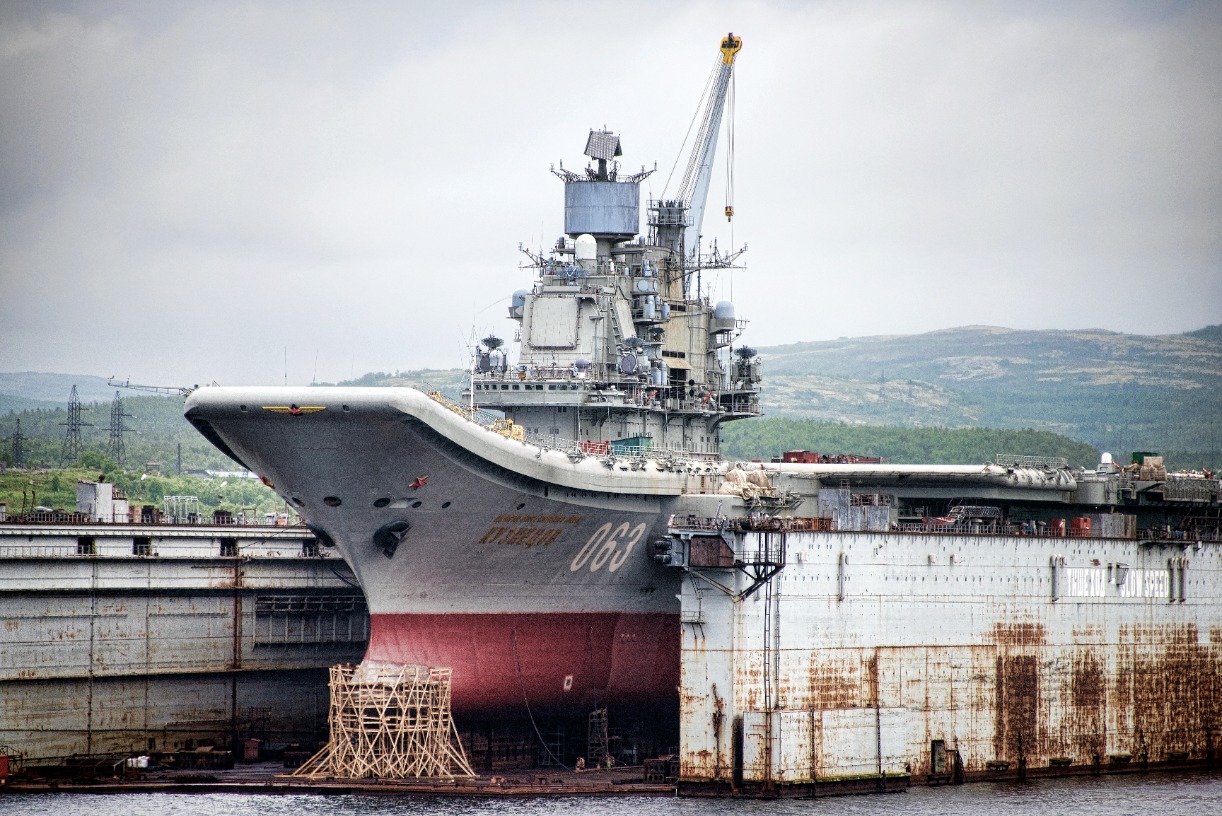Admiral Kuznetsov: Russia's Aircraft Carrier Might Be 'Sidelined' Forever
Admiral Kuznetsov was supposed to venture from the port of Murmansk this year after spending nearly a decade tied to the dock. According to Russian state-run media last summer, the country’s only aircraft carrier was nearing the end of its refit saga.
Summary and Key Points: Russia’s sole aircraft carrier, Admiral Kuznetsov, has been plagued by endless modernization efforts, design flaws, and operational failures. Initially constructed during the Cold War, the carrier has struggled with outdated technology, including its reliance on mazut fuel, which complicates its operations.
-Despite plans to return to service in 2024, ongoing issues, such as defective piping and boiler systems, coupled with a history of mishaps, make its future uncertain.
-As Russia continues its invasion of Ukraine, resources for the carrier’s repair are limited, raising the question of whether Moscow should scrap Kuznetsov altogether.
Admiral Kuznetsov: Should Russia Scrap Its Troubled Aircraft Carrier?
The refit of Russia’s sole aircraft carrier goes on with no end in sight. For years now, Admiral Kuznetsov has been virtually wasting away at various shipyards as it undergoes “modernization” efforts on drydock. The plagued carrier might not ever enter service again. Even if the flagship of the Russian Navy does make it back out to sea, its troubled history, design flaws, and underwhelming capabilities will sideline the vessel. It will be more of a burden than an asset.
Admiral Kuznetsov was supposed to venture from the port of Murmansk this year after spending nearly a decade tied to the dock. According to Russian state-run media last summer, the country’s only aircraft carrier was nearing the end of its refit saga.
But this did not happen. The Soviet-era flattop remains dry-docked in Murmansk. As TASS reported: "According to the adjusted plan, factory sea trials of the aircraft carrier should begin in the spring of 2024. If the tests pass without glitches, then the ship can be handed over to the fleet at the end of 2024. If something goes wrong during the tests, then a shift to 2025 is inevitable."
Clearly, Kuznetsov did not pass these initial tests.
Introducing Admiral Kuznetsov
Russia’s sole carrier was constructed by the Black Sea Shipyard during the Cold War and officially launched in the mid-1980s. Intended as the lead ship of a two-ship Kuznetsov class, the dissolution of the Soviet Union left Kuznetsov an only child.
Kuznetsov was originally laid down as “Riga,” followed by “Leonid Brezhnev” and later “Tbilisi.” Ultimately, the carrier was renamed to honor Soviet Admiral Flota Sovetskoho Soyuza Kuznetsov. The Soviets intended Kuznetsov to function as a heavy aircraft-carrying cruiser during the Cold War, capable of supporting and defending missile-carrying submarines and other aircraft. However, the carrier’s design flaws, infrastructure issues, and perhaps bad luck have prevented her from achieving any of these missions.
Russia’s Sole Aircraft Carrier May Be Cursed
Unlike modern carriers that are powered by nuclear energy, Kuznetsov runs on a goopy, tar-like substance called mazut. During the Cold War, this fuel source was popular due to its thick viscosity. While older military and commercial vessels relied on mazut in the past, the substance’s numerous shortcomings have led manufacturers to use nuclear or gas turbine propulsion systems instead.
Kuznetsov was simply not built to withstand its intended service life. Poor piping installed during the carrier’s initial construction prevents its boilers from operating at full capacity simultaneously. This issue has only confounded the mazut’s drawbacks, as proper boiler and piping installations are required to ensure it can be adequately preheated and pressurized.

As previously detailed by Harrison Kass, “Mazut would be considered a Bunker B or Bunker C fuel. Bunker fuels, which is a colloquial term for the fuel oil that marine vessels use, are divided into A, B, or C classifications, based on their boiling points, carbon-chain lengths, and viscosities. A is the highest quality classification. C is the lowest. Lower quality fuel emissions, like mazut’s, typically produce large amounts of sulfur and have negative effects on the environment and human health.”
Kuznetsov’s mazut issue is not the carrier’s only limiting factor. The Russian carrier uses a simple bow ramp to carry out flight operations, while its foreign near-peers have shifted to magnetic-powered catapults and steam-powered catapults that work much better. The first and only time Kuznetsov used this system in combat was in 2016-2017, when she deployed to Syria. Two airframes were lost due to faulty arresting wires during this stint in the Middle East, essentially proving the carrier useless.
Should Moscow Scrap Admiral Kuznetsov Once and for All?
Kuznetsov’s Syria deployment is just one chapter in a desultory history. Between 2016 and 2022, the carrier suffered from multiple fires onboard, a falling crane, and even a crime of embezzlement relating to the shipyard where she once underwent repairs. It appears Kuznetsov will not re-enter service with the Russian Navy as planned by the end of the year.
Considering the ongoing invasion of Ukraine, it is unlikely the carrier will receive enough resources, funding, and labor to enable her to sail the seas any time soon. Perhaps nixing Kuznetsov altogether is the best plan of action for Moscow.
About the Author: Maya Carlin
Maya Carlin, National Security Writer with The National Interest, is an analyst with the Center for Security Policy and a former Anna Sobol Levy Fellow at IDC Herzliya in Israel. She has by-lines in many publications, including The National Interest, Jerusalem Post, and Times of Israel. You can follow her on Twitter: @MayaCarlin.
Image Credit: Creative Commons and/or Shutterstock.


